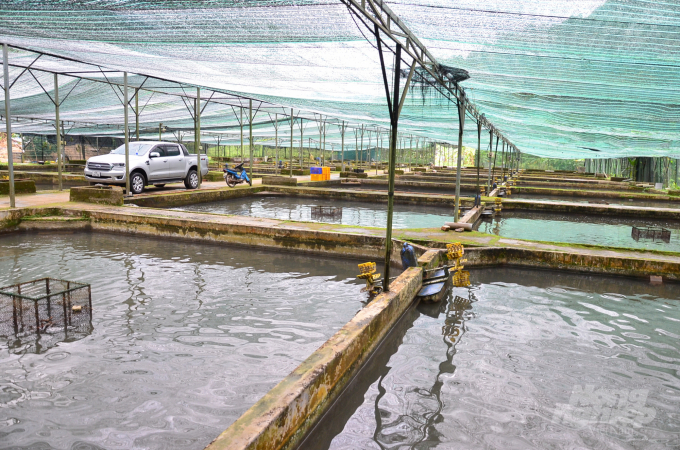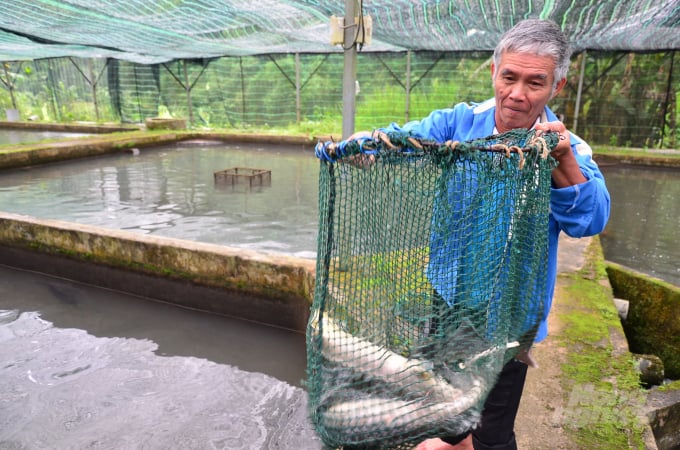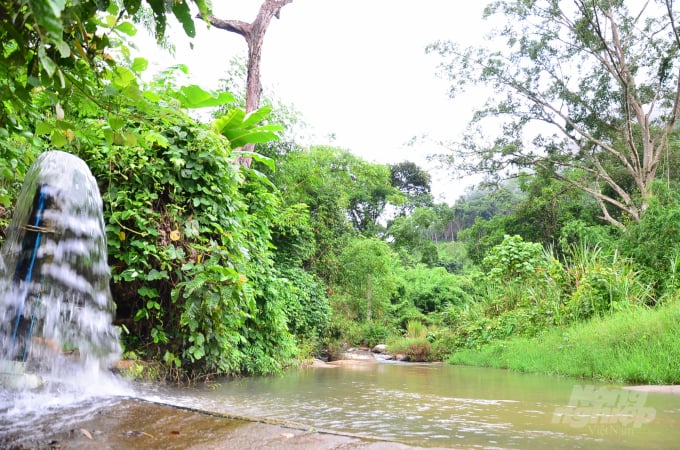May 30, 2025 | 14:45 GMT +7
May 30, 2025 | 14:45 GMT +7
Hotline: 0913.378.918
May 30, 2025 | 14:45 GMT +7
Hotline: 0913.378.918

Dr. Nguyen Viet Thuy ‘s commercial sturgeon farm. Photo: Duong Dinh Tuong.
Only 1 km from the sturgeon hatchery, Dr. Nguyen Viet Thuy (Research Institute of Aquaculture No. 3, Ministry of Agriculture and Rural Development) also has a commercial sturgeon farm.
That afternoon, in Lan Tranh village, Dung K'No commune (Lac Duong district, Lam Dong province), he gave us an enchanting experience of wine, grilled sturgeon and sturgeon hot pot in the middle of the windy hut.
To tell the truth, I have eaten sturgeon in many parts of the country, but I have never felt such a deliciousness anywhere. The meat was sweet, crispy and gave out such a pleasant scent that it makes me give up all the formality. My chopsticks acted non-stop, and my mouth wouldn’t stop working. Looking outside, the old forest enveloped us. The chirping birds and fluttering butterflies made one feel like wanting to get rid of all the dust and dirt of a tiring human life.
Seeing that I had finished eating and was about to open my camera bag to take some photos of the sturgeon fish tanks, Tung quickly intervened, "This place is still small in scale, what's the point of taking pictures. I'll take you to another farm in a little while. It’s also in this commune, but bigger."
Going approximately 15-20 km following the mountain road, we reached the camp when it was late at night. That night, after a warm meal, alcohol plus the cool mountain air, I slept tight and only woke up to the sound of rain falling on the corrugated iron roof. Somewhere, there was the sound of people's footsteps passing by, flashlights flickering. It was still pitch black outside, I clicked on the phone and saw that it was only 4 am. But I could not sleep anymore, so I rubbed my eyes and headed to the direction of the noise.
Turned out it was Le Van Truong, who is in charge of the fish farming area, and another colleague who got up at what time to feed the fish following the daily schedule (4:30 pm, 9:30 pm and 4 am). The reason for feeding at that time was because the sturgeon has a habit of hunting in low light. After feeding the fishes, Truong picked up the weak or dead fish from the water and then clicked on the counter tied to a pole at the corner of the tank. Every month, they would look at the numbers on the machine to know the rate of fish loss, which is very convenient, not having to write down on a record note like they used to do.

With the price of VND 180,000/kg, the goods are sold so fast that there aren’t enough to sell. Photo: Duong Dinh Tuong.
The farm has 36 commercial fish tanks of 100 m2 wide and more than 1 m deep, raising a total of 1,250 fish; 8 small aquariums and 1 nursery to raise newly hatched fish. Many people would be surprised to know that each of those small tanks full of tiny fish can make enough money to buy a car of more than VND 500 million when released for sale.
The farm is just over 0.5 ha, and the total investment is somewhere around 15 billion VND, but each year sells 160 - 170 tons of sturgeon. With the price of VND 180,000/kg, the goods are sold so fast that there aren’t enough to sell. The total revenue is more than VND 20 billion, hence the profit is more than 50% because the production unit works "from A to Z", only buys feed from outside.
I dare say it is rare for any type of fish farming to give such a high income. When fully calculated, this type of farming can give yield of 260 tons/ha, allowing the farm to collect VND 35-40 billion/ha/year.

The fresh and clean water flowing from the Bidoup old forest. Photo: Duong Dinh Tuong.
I know many agricultural experts who are very good at "making the big talk" when teaching the people about the profession, but lose a lot of money when they opened a farm to grow crops or raise livestock themselves and soon had to close down.
But Thuy is different from those "experts". He currently has a total of 5 sturgeon farms, both seed and commercial, raising a stable output of more than 300 tons of commercial fish per year and has initially been successful in artificial insemination of broodstock.
Regarding sturgeon fishery, the experience is not simply about farming techniques but also about knowing how to calculate the amount of flood water when seeing the river stream and how to build the farm to ensure safety and production efficiency.
“In sturgeon fishery, there must be a separation between seed production and commercial farming. Breeding sturgeon is so difficult that the price of 1kg of eggs in the world can cost over USD 5,000.
“Commercial sturgeon farming is actually not too difficult for people, the problem is to choose a location on the top of a stream in a forest where no one is engaged in agricultural production, cutting trees or causing pollution. Next is to ensure optimal temperature conditions, not all streams can raise sturgeon but it must be cold water springs from 18-24 oC. The large or small scale depends on whether the water source is abundant or not. The third condition is the capital because raising sturgeon requires big investment. The fourth is the ability to receive knowledge and techniques of the household head, but in fact, this requirement is only average in the requirement list.
“I have been working for a long time, so whenever anyone asks, I advise. In the process of selling seeds to farmers, I also guide them in detail about caring and feeding techniques. Occasionally there are training classes for farmers, and I am often invited to teach. I have now completed the sturgeon raising procedure, and I can give it to farmers. Just take care of the fish accordingly and the success rate would be 70-80%. The remaining 20-30% depends on raising the fishes on a sufficient scale, and it takes time for the people to gain a certain amount of experience," said Thuy.
Translated by Samuel Pham
/2025/05/25/4127-3-073637_820.jpg)
(VAN) Thanks to the promotion from an FAO-implemented project, vegetable production in greenhouses in Moc Chau has seen strong development, from 1.5 hectares in 2021 to nearly 50 hectares in 2024.

(VAN) FAO has recently supported USD 140,000 to implement the project 'Risk mitigation human-animal interface risks through disease control initiatives in pig farming.'

(VAN) The People's Committee of Tra Vinh province has approved an adjustment to the investment policy for the Green Hydrogen Plant project, increasing its area to approximately 52.76 hectares.
![Reducing emissions from rice fields: [2] Farmers’ commitment to the soil](https://t.ex-cdn.com/nongnghiepmoitruong.vn/608w/files/news/2025/05/05/dsc08881jpg-nongnghiep-140632.jpg)
(VAN) Clean rice cultivation model in Thuong Tan commune, Bac Tan Uyen district, is assisting local residents in achieving sustainable agriculture by substantially reducing costs, increasing productivity, and protecting the environment.

(VAN) At the conference to disseminate Resolution No. 68, AgriS introduced its digital agricultural ecosystem and reaffirmed its commitment to accompanying the Government in promoting private sector development and sustainable agriculture.

(VAN) 'Blue Ocean - Blue Foods' initiative is designed to restore marine ecosystems and establish sustainable livelihoods for local communities by cultivating a minimum of 1,000 hectares of cottonii seaweed in the first three years.
/2025/05/21/4642-3-112707_603.jpg)
(VAN) The V-SCOPE project has made direct contributions to three out of six pillars of the Comprehensive Strategic Partnership between Vietnam and Australia.